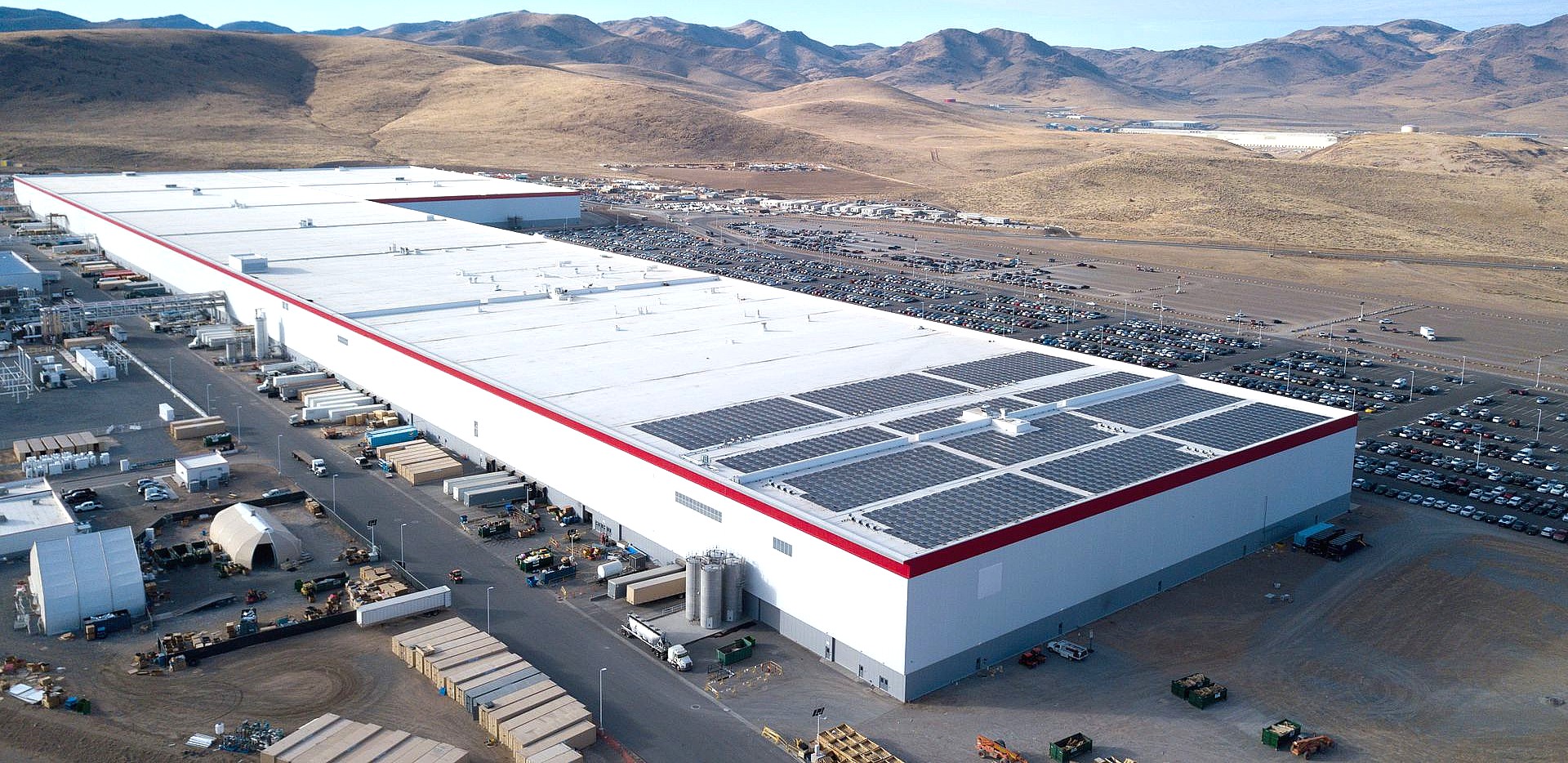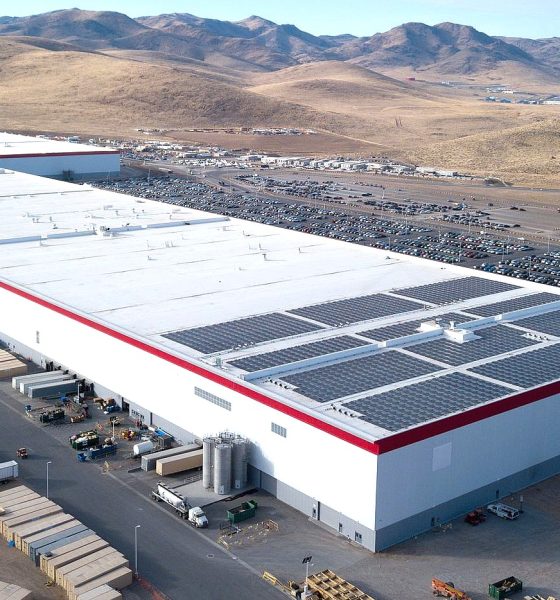

News
Tesla partner Panasonic shares details of Gigafactory Nevada’s major expansion
It appears that Tesla’s battery partner, Panasonic, is preparing for a massive ramp in Gigafactory Nevada, with an executive stating that the Japanese firm will be rolling out a major expansion of its operations on the site. These include the installation of new equipment and the hiring of more workers, which would allow Giga Nevada to produce battery cells at higher rates than before.
Panasonic’s expansion was recently confirmed by Carl Walton, vice president of production engineering and facilities for Panasonic Energy of North America, who shared the updates in a conversation with the Reno Gazette-Journal. According to Walton, some of the expansion should take place within the next few months, and it will likely continue all the way to next year.
“There’s some construction work that needs to take place over the next couple of months. Then early next year, we’ll be installing new equipment with production starting shortly after that,” he said.
The additional capacity will be coming from a 14th battery production line that Panasonic will be adding to Giga Nevada. Walton declined to give the exact number of GWh that the planned expansion will add to the facility’s capacity, though he noted that Panasonic expects the facility’s capacity to increase by about 10% with the upgrades in place. It should be noted that currently, Gigafactory Nevada has a capacity of about 35 GWh per year.
Walton further noted that with the expansion in place, Panasonic will be hiring more employees for Giga Nevada. That being said, the executive noted that the planned hiring ramp will only include about 100 new positions, hinting at the possibility of the 14th line being heavily automated. “The expansion will increase our staffing by about 100 positions. We’re excited to continue our investment in the Northern Nevada community and our people here,” Walton stated.
While speaking with the Gazette-Journal, Walton added that the expansion plans for the Tesla site will not be limited to the new battery cell production line, since existing lines will also be receiving significant upgrades. These upgrades, the exec explained, are necessary to accommodate a new generation of battery cells. “That work is starting now and we’ve already started to convert current equipment to be able to make those batteries for us,” Walton remarked.
Interestingly enough, the Panasonic executive provided some details about the next-generation battery cells that will be produced at Gigafactory Nevada. According to Walton, Panasonic’s latest battery improves energy density by 5% compared to its previous cells. The company also claimed that its new cells are 1.4x denser than competing iron phosphate batteries, making them the world’s highest energy density batteries. These improvements are but a step, however, as Panasonic is reportedly looking to increase the energy density of its battery cells by 20%.
Panasonic’s confirmation of its planned expansion in Gigafactory Nevada highlights the Japanese firm’s strong working relationship with Tesla. Last year, a report from the Nikkei Asian Review, which cited very little sources, alleged that Panasonic was freezing its expansion plans in Giga Nevada. Panasonic Chief Executive Officer Kazuhiro Tsuga also commented on Tesla CEO Elon Musk’s “unpredictable” behavior on Twitter. Musk, for his part, noted that Panasonic has been the reason behind Giga Nevada’s battery supply constraints.
With the recent statements from Walton, however, it appears that both companies now stand on much firmer ground. Panasonic’s expansion of its Gigafactory Nevada operations seems to be a strong strategy this year, after all, especially since its battery business in the Tesla facility has proven profitable even from January to March 2020, a time that is marred by the start of the pandemic. And with electric cars becoming more popular, the Japanese firm will likely have its hands full trying to meet the battery demand for Tesla’s electric vehicles.

News
Tesla FSD fleet is nearing 7 billion total miles, including 2.5 billion city miles
As can be seen on Tesla’s official FSD webpage, vehicles equipped with the system have now navigated over 6.99 billion miles.

Tesla’s Full Self-Driving (Supervised) fleet is closing in on almost 7 billion total miles driven, as per data posted by the company on its official FSD webpage.
These figures hint at the massive scale of data fueling Tesla’s rapid FSD improvements, which have been quite notable as of late.
FSD mileage milestones
As can be seen on Tesla’s official FSD webpage, vehicles equipped with the system have now navigated over 6.99 billion miles. Tesla owner and avid FSD tester Whole Mars Catalog also shared a screenshot indicating that from the nearly 7 billion miles traveled by the FSD fleet, more than 2.5 billion miles were driven inside cities.
City miles are particularly valuable for complex urban scenarios like unprotected turns, pedestrian interactions, and traffic lights. This is also the difference-maker for FSD, as only complex solutions, such as Waymo’s self-driving taxis, operate similarly on inner-city streets. And even then, incidents such as the San Francisco blackouts have proven challenging for sensor-rich vehicles like Waymos.
Tesla’s data edge
Tesla has a number of advantages in the autonomous vehicle sector, one of which is the size of its fleet and the number of vehicles training FSD on real-world roads. Tesla’s nearly 7 billion FSD miles then allow the company to roll out updates that make its vehicles behave like they are being driven by experienced drivers, even if they are operating on their own.
So notable are Tesla’s improvements to FSD that NVIDIA Director of Robotics Jim Fan, after experiencing FSD v14, noted that the system is the first AI that passes what he described as a “Physical Turing Test.”
“Despite knowing exactly how robot learning works, I still find it magical watching the steering wheel turn by itself. First it feels surreal, next it becomes routine. Then, like the smartphone, taking it away actively hurts. This is how humanity gets rewired and glued to god-like technologies,” Fan wrote in a post on X.
News
Tesla starts showing how FSD will change lives in Europe
Local officials tested the system on narrow country roads and were impressed by FSD’s smooth, human-like driving, with some calling the service a game-changer for everyday life in areas that are far from urban centers.

Tesla has launched Europe’s first public shuttle service using Full Self-Driving (Supervised) in the rural Eifelkreis Bitburg-Prüm region of Germany, demonstrating how the technology can restore independence and mobility for people who struggle with limited transport options.
Local officials tested the system on narrow country roads and were impressed by FSD’s smooth, human-like driving, with some calling the service a game-changer for everyday life in areas that are far from urban centers.
Officials see real impact on rural residents
Arzfeld Mayor Johannes Kuhl and District Administrator Andreas Kruppert personally tested the Tesla shuttle service. This allowed them to see just how well FSD navigated winding lanes and rural roads confidently. Kruppert said, “Autonomous driving sounds like science fiction to many, but we simply see here that it works totally well in rural regions too.” Kuhl, for his part, also noted that FSD “feels like a very experienced driver.”
The pilot complements the area’s “Citizen Bus” program, which provides on-demand rides for elderly residents who can no longer drive themselves. Tesla Europe shared a video of a demonstration of the service, highlighting how FSD gives people their freedom back, even in places where public transport is not as prevalent.
What the Ministry for Economic Affairs and Transport says
Rhineland-Palatinate’s Minister Daniela Schmitt supported the project, praising the collaboration that made this “first of its kind in Europe” possible. As per the ministry, the rural rollout for the service shows FSD’s potential beyond major cities, and it delivers tangible benefits like grocery runs, doctor visits, and social connections for isolated residents.
“Reliable and flexible mobility is especially vital in rural areas. With the launch of a shuttle service using self-driving vehicles (FSD supervised) by Tesla in the Eifelkreis Bitburg-Prüm, an innovative pilot project is now getting underway that complements local community bus services. It is the first project of its kind in Europe.
“The result is a real gain for rural mobility: greater accessibility, more flexibility and tangible benefits for everyday life. A strong signal for innovation, cooperation and future-oriented mobility beyond urban centers,” the ministry wrote in a LinkedIn post.
News
Tesla China quietly posts Robotaxi-related job listing
Tesla China is currently seeking a Low Voltage Electrical Engineer to work on circuit board design for the company’s autonomous vehicles.

Tesla has posted a new job listing in Shanghai explicitly tied to its Robotaxi program, fueling speculation that the company is preparing to launch its dedicated autonomous ride-hailing service in China.
As noted in the listing, Tesla China is currently seeking a Low Voltage Electrical Engineer to work on circuit board design for the company’s autonomous vehicles.
Robotaxi-specific role
The listing, which was shared on social media platform X by industry watcher @tslaming, suggested that Tesla China is looking to fill the role urgently. The job listing itself specifically mentions that the person hired for the role will be working on the Low Voltage Hardware team, which would design the circuit boards that would serve as the nervous system of the Robotaxi.
Key tasks for the role, as indicated in the job listing, include collaboration with PCB layout, firmware, mechanical, program management, and validation teams, among other responsibilities. The role is based in Shanghai.
China Robotaxi launch
China represents a massive potential market for robotaxis, with its dense urban centers and supportive policies in select cities. Tesla has limited permission to roll out FSD in the country, though despite this, its vehicles have been hailed as among the best in the market when it comes to autonomous features. So far, at least, it appears that China supports Tesla’s FSD and Robotaxi rollout.
This was hinted at in November, when Tesla brought the Cybercab to the 8th China International Import Expo (CIIE) in Shanghai, marking the first time that the autonomous two-seater was brought to the Asia-Pacific region. The vehicle, despite not having a release date in China, received a significant amount of interest among the event’s attendees.








